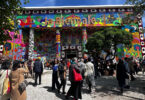Ed Brodkin has achieved his lifelong dream of becoming a full time fine artist. After graduating from Cooper Union, he worked as a commercial artist. Now retired from the “Mad Men” world, he devotes himself to painting—as he says “full time, every day.”
Stylistically experimental with works ranging from figurative to abstract, his paintings defy strict categorization. In fact, at a recent show at the Pleiades Gallery in Chelsea, only a mastery of tonal contrasts, a bold use of lights and darks, suggested that these various works were by the same artist.
Brodkin’s surfaces swarm with detail, texture, and barely visible echoes of what he sees. Most of his paintings are existential contemplations. “Portals,” an acrylics, graphite, and paper collage with black velvet panels, is highly enigmatic. “We don’t know where those portals will lead or what is on the other side of my black velvet doors,” he says. “That sense of mystery is what I try to imbue in this and many of my paintings.”
Brodkin admits that he loves to concentrate on philosophical ideas. He is a serious man, well spoken, and somewhat professorial. “My pieces have to be conceptually compelling but also aesthetically pleasing,” he says. With “Cityscape XII” the artist explores irregular shapes and three dimensionalities using cardboard, canvas, and Masonite. The cardboard towers resemble a piece of Futurist sculpture with their thrusting verticals, but the intent is to make you stop and consider how the incessant construction of tall buildings will affect the future cityscape.

LISTEN! Thunderclaps! Echoes! Over Long Island!
It is with two paintings about a thunderstorm on Greenwood Lake in Northern New Jersey that this versatile painter expresses his intense interest in nature. Both “Listen! Thunderclaps! Echoes! Over Long Pond,” acrylics on crinkled paper on a black painted canvas, and “Come the Furies Over Long Pond” capture the energy emitted by serious claps of thunder. “I used burlap on canvas as I was experimenting with materials,” says Brodkin. Inspired by the work of Catalan painter Antoni Tapies (1923-1988) who used everything from waste paper, string, and rags on his paintings, Brodkin incorporates discarded materials in his work so that his surfaces have a variety of textures. A kind of alchemy takes place from this use of mixed-media, transforming what might have been a typical painting of a thunderstorm into something much more menacing and captivating. These storm are the visual equivalent of perfect pitch. Their detailed observation is not at all complete representation, but delivers the effect of hearing, seeing, and not quite believing the power of what you are witnessing.
One painting in his recent show, “Kiki & Kelly…For as Long as Songbirds Sing,” is a tribute to two outstanding women: his wife Kiki, a well-known, accomplished artist who died five years ago, and Kelly, the daughter of a close friend, a former model and nurse, who died at an early age. The style is pure Warhol. The work consists of a series of head shots of the two women. Like Warhol’s Jackie or Marilyn series, they are posterized photographs, reproductions having only solid tones and little detail.
“Very Untitled,” is a teaser, a sort of cosmic painting that depicts dark matter with perhaps images of stars or galaxies connected to each other by thin, crisscrossing lines. “All the elements of the universe are connected visibly,” says Brodkin who likes to work with irregular forms. He began “Very Untitled” with a rectangular piece of fiber board and then started changing its shape with a coping saw. But don’t be misled. This is not a depiction of a beautiful starry night. Instead, “it is an imagined universe,” he says, “beyond our understanding.”
Scrutiny of nature is a major theme in Brodkin’s work. Equally important are his investigations into communication or the lack of it. Brodkin has focused on misunderstandings among peoples, cultures, and countries since he was an art student. “Discourse,” a major work in the Pleaides exhibition, incorporates letters from a medieval manuscript in 20 identical squares. “Some of the messages within the squares are connected while others are ambiguous,” he says. “In conceiving this piece I thought a lot about the challenges of miscommunications. They are as problematic today as they have been over time.”
Brodkin does most of his work in a studio with a 12-foot window in his house in Paramus, New Jersey. He can do almost any type of work there except welding. Years ago, he found that he was allergic to turpentine so he switched from oil painting to acrylics which play a major role in his paintings.
“I have always been intrigued with man’s place in this world,” he says. “That is why I experiment, not to necessarily find answers, but to be a seeker, someone who not only wants to link colors together, but also people.” Crossing lines between figurative and abstract is another of his efforts to get away from the conventional, according to this very unconventional painter.




